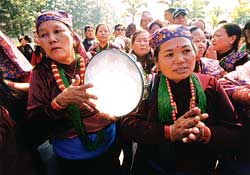 Last month my family celebrated Lhosar near London at a show arranged by the Tamu Dhin (Gurung Home) Association. Gurungs, mainly from army backgrounds, founded this association with the primary purpose of teaching their children the culture of their forefathers. Yet nowadays the New Year event attracts over 1,300 Nepalis from across the community to share the celebration. It is important that in the UK, the Tamu people welcome guests from all backgrounds, because it fosters a real sense of kinship and goodwill from which no one is left isolated.
Last month my family celebrated Lhosar near London at a show arranged by the Tamu Dhin (Gurung Home) Association. Gurungs, mainly from army backgrounds, founded this association with the primary purpose of teaching their children the culture of their forefathers. Yet nowadays the New Year event attracts over 1,300 Nepalis from across the community to share the celebration. It is important that in the UK, the Tamu people welcome guests from all backgrounds, because it fosters a real sense of kinship and goodwill from which no one is left isolated. The myriad of over 60 caste and ethnic groups that live side-by-side in the hills and tarai, are one of Nepal's much celebrated features. Consolidated in the Constitution of 1990 as a "multi-ethnic, multi-lingual. Hindu and constitutional monarchical kingdom", Nepali society continues to swing between caste and ethnic loyalty, and the broader national Nepali identity. These bold statements masked a reality in which the majority of ethnic groups remained on the periphery of national development, falling behind in terms of employment and education, whilst a tiny urban elite reaped the benefits of a new economic freedom. Since the introduction of the new constitution and multiparty democracy in 1990, many of these ethnic groups organised themselves to promote their rights, languages and cultures.
Ethnicity has become increasingly prominent in the current political troubles, often being used as a rallying call for dissent and dissatisfaction. Groups like the Khumbuwan in the east, and the Tharu Mukti Morcha in the west have thrown in their lots with the Maoist insurgents. The state, for its part, has shown its mistrust of ethnic organisations (even those with no links to the conflict), as demonstrated in the arrests and 'disappearance' of members of the Newar Khala and Tamang Ghedung in the Kathmandu Valley over the last few months. In the modern context, multi-ethnic Nepal seems to be less a cause for celebration, but in political perceptions at least, a threat to national stability.
The Nepali community in the UK has come a long way from its very limited origins--the first migrants arrived in London in the 1960s and British Army Gurkhas began to be stationed in Britain in the early 1970s. Today there are more than 20,000 Nepalis living here, including students, workers, restaurant owners, professionals and soldiers, from many regions of Nepal, and representing a range of ethnic backgrounds. Yet, life in the UK does not lend itself to the social ties and structures that are left behind in Nepal. Family, village, caste and ethnic group provide support and a sense of identity to individuals in Nepal, to the extent that Nepali nationhood often takes second place to family and clan loyalty.
The lack of all these things in London has required a social shift within the Nepali community, to a system of support and identity that breaks down the barriers of ethnicity and caste. Perhaps it is the hard economic environment in the UK and the relatively small population of migrant groups living here that makes people stick together regardless of creed and colour. The Pakistani and Bengali communities are already well-established here and use their nationalities as the basis for mutual support. The Nepali community is now also finding that a Nepali national identity can be a source of strength and unity here in the UK.
In Nepal it is understandable that groups wish to protect their culture and traditions from the bland, homogenising force of Western development and Kathmandu. Arbitrary attempts to forge a single national identity at the cost of minority cultures and language cause resentment, history shows that such policies are doomed to failure. Nepali national identity ultimately stems from the very diversity of culture, religion and language that is currently being dragged through the mud and blood of violent conflict as Maoists seek to divide the people, whilst the government finds itself unable to trust the basic desires and needs of its own multi-ethnic population.
Life over here in the UK is far from perfect, but the community has developed a new model of society to try and cope with the pressures, a reinterpretation of Nepali culture, which looks beyond pigeonholing and dividing Nepalis along ethnic lines. A community that looks beyond its internal ethnic divisions can find strength in its increased numbers, and celebrate the diverse array of cultures whilst sharing a common identity, a sense of nationhood in exile. During this Lhosar it was fantastic to see the ease with which people came together and celebrated regardless of their backgrounds, what they had in common was their Nepali identity.
ED Bowman works for Amnesty International's Nepal, Bhutan and Sri Lanka desk.



